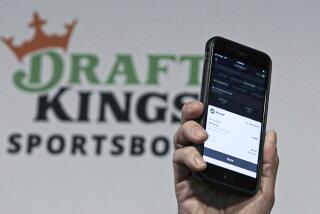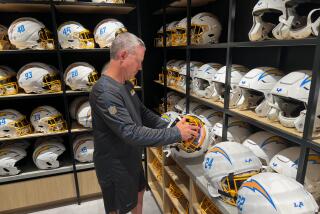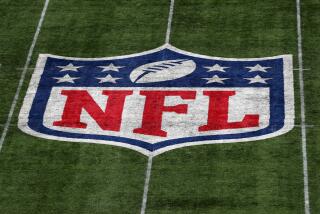NFL Trading-Card Business Isn’t Child’s Play : Pro football: With millions at stake, it has created another wedge between players’ union and owners.
For the young at heart, kids and adults alike, trading cards are what marbles used to be: symbols of hope, challenge and acquisition.
Among other things.
One of the other things--in pro football today--is trouble.
The NFL’s 28 club owners and their 1,500 players are in a strange, heated scrap over football trading cards, believe it or not.
In a conflict that might be comical if it weren’t so critical financially, they are quarreling not as collectors but as providers--as licensing agents for the businesses that manufacture and distribute the cards.
And as usual, money is the root of the evil.
The players have taken the owners to court, charging that the league is illegally spending more than $7 million to interfere with the rights of the NFL Players Assn. to market the names and pictures of its own members.
“Licensing revenue is all that keeps us going,” NFLPA attorney Jeffrey L. Kessler said the other day. “It has supported the association since the (owners) took away the dues check-off three years ago. Now, once more, they’re striking at our only revenue source. The (owners) are trying to steal the (players’) marketing rights.”
Said NFLPA executive director Gene Upshaw: “Their objective is to cripple us economically so we can’t afford to fight for the players in court.”
Michael Duberstein, NFLPA director of research, was even more blunt.
“The (owners) are trying to put us out of existence,” he said. “More than 90% of the players have legally authorized the (NFLPA) to represent them in a group licensing program, but the NFL keeps (going after them).
“They are bribing players $5,000 all the way up to $100,000. And if (the owners) win this fight, the NFLPA is gone. We’re out of business.”
The league denies all charges of illegality and counters that it is simply in competition with the NFLPA in the surprisingly lucrative, wildly expanding trading-card business.
“We’ve been more aggressive in doing things lately, and that makes the players’ association unhappy,” said David Boss, West Coast vice president of NFL Properties, Inc., the owners’ licensing arm. “Competition is what this is all about.”
John H. Flood III, executive vice president of NFL Properties, confirms that his organization has guaranteed $100,000 a year to each of 11 top NFL quarterbacks and that they have formed a “Quarterback Club” to represent themselves and the owners exclusively--at the expense of the NFLPA majority.
“The guarantee is for five years,” Flood said. “We’ve also (guaranteed) $5,000 apiece to 300 other players in our Pro Line trading-card program.”
That’s $1.5 million for 300 of the league’s best-known players--plus $5.5 million for the quarterbacks who decided to revoke their group licensing pledges to the NFLPA--or a $7-million indication that the owners are serious.
The other players in the players’ association are excluded from the new ventures--and that is the bone of contention.
“They can’t revoke,” the players’ lawyers said.
“They can,” the owners’ lawyers said.
And if the owners prevail in federal court this summer, the NFLPA will be on the ropes, if not out of business.
It has no other adequate source of income.
TRADING CARD EXPLOSION
For years, the NFL used to say: “The game is the thing.” But that is no longer true. Big business is the thing now.
NFL television revenue has risen, for example, to match gate revenue. Thus each owner is averaging $32 million in annual TV income. And, suddenly, marketing income is rising steeply, too.
Gross sales of NFL-licensed products topped $1.5 billion last year, netting each club owner about $1.5 million. And as the gross climbs toward $2 billion this year, the owners are projected to net at least $2 million apiece, Flood said.
Football’s marketing explosion of the late ‘80s has benefited the players also.
Their take from NFLPA-licensed products rose from $450,000 in 1985 to $4.5 million in 1989. And last year it reached $11.6 million, Upshaw said--enough to fund the association without asking the players for dues payments.
Indeed, the NFLPA has embarked on a $3-million rebate program for those who paid their dues in 1987-89. No payments were required in 1990.
Unlike the NFL, however, which gets a lot of apparel-licensing income, 80% of the NFLPA’s marketing income is in trading cards, Doug Allen, the players’ assistant executive director, said in a revenue comparison.
There are seven different manufacturers in the pro football trading-card business--Score, Topps, Fleer and Pro Set among them--promoting more than 750 members of NFL teams.
“The fans love those (cards),” Allen said. “There’s something about a trading card that makes a football player seem human, and the demand is increasing all the time.”
The demand, according to Flood, was largely created by the owners.
“Two years ago, Topps was the only trading-card account the union had,” he said. “The work we did with Pro Set is what generated the big money.”
Said NFLPA general counsel Richard Berthelsen: “Not true. To hear them tell it, the NFL also invented football.”
In any case, revenues have become so sizable that the NFLPA could budget $3.3 million this year to battle the NFL in antitrust and other courtroom cases.
“That’s what bothers the (owners),” Allen said. “That’s what triggered this fight. The league wants to dry up the (millions) we spend in court each year defending player rights. They’re out to torpedo us financially by stealing our players.”
Speaking for the league, Flood said: “That’s nonsense. Our job is simply to (make money) for the NFL. We have a right to compete.”
Said NFLPA lawyer Kessler: “But there are rules of competition--and the (owners) are illegally flouting the rules.”
The fuss, in common with all recent labor-management troubles in pro football, is related to the possibility that the annual college player draft next spring will be the NFL’s last.
The courts have said that a renewal of the draft needs the authorization of the players, who have been maneuvering to avoid just that--decertifying as a union, for one thing, and then, in numerous court cases, financing the bolder players suing for free agency.
The league at the same time, expressing confidence that the courts will grant it a draft extension, has been maneuvering to improve its chances by obtaining another player endorsement:
--First, in an effort to make the players weaker and more dependent, the owners ended the NFLPA dues checkoff on paychecks.
--Next, they tried to displace the NFLPA with a company union that would willingly extend the draft. The owners supported, in turn, three different would-be union organizers, former player Tom Gatewood, agent Art Wilkinson and former player Larry Csonka, all of whom misfired.
--Finally, and most ambitious of all, the owners eased into their current campaign, setting out to pick off the players one by one in a strategic effort that the NFLPA calls divide and conquer.
“It won’t work,” sports lawyer Leigh Steinberg said. “The draft is dead. The concept of drafting employees in a free-enterprise society is so antithetical to (U.S.) business practices and constitutional values that it will cease to exist in (1992).”
THE NFL’s NEW HARD LINE
It has been nine years since the NFL’s players and owners signed their last collective bargaining agreement, a five-year contract that was in force when a remarkable thing happened in the nation’s business community: A considerable number of manufacturers, retailers and other promoters and advertisers determined to tie in with pro football.
Slowly at first, but surely, the pros accommodated their admirers in two ways:
--The NFL, for a price, granted them permission to use the names, colors and symbols of the teams.
--The NFLPA, for a price, gave them permission to use the names and pictures of the players.
By late 1990 there were 200 manufacturers distributing 400 products licensed by NFL owner or player groups, or both.
In the beginning, when revenues were comparatively small, the cooperative system worked, for everyone welcomes spare change. Then as now, the players put theirs into their historically cash-poor union, and the owners, at first, put theirs into charity.
Church people, for instance, or youth groups, appealing to the owner of their favorite NFL team for financial help, were deflected to NFL Properties, the holding company for receipts reaped on the side and at that time reserved, exclusively, for charity bequests.
But as the ‘80s waned, a new type of NFL owner moved in. Typically, having paid $75 million or more for the franchise, much of it borrowed, this type looked for an additional source of important income.
And found it in the ranks of manufacturers and distributors of garments, computer games and trading cards--among other businesses promoting NFL-branded products.
So far, so good. Owners and players, alike, began making millions where, previously, NFL charities had been content with hundreds of thousands, and where, indeed, charity is still picking up an annual average of $500,000.
Then last year, abruptly, the owners unilaterally embraced a new strategy.
Noting that they had already done plenty for the players, they came up with some imaginative new licensing schemes that cut out most of the help.
For one thing, a famous-name Quarterback Club was formed to divide the receipts from several multimillion-dollar deals. Cutting in are 28 owners and 11 quarterbacks--instead of the full complement of 1,500 players.
In another scheme, the owners arranged their own trading-card line, agreeing to share the rewards with 300 players--instead of 1,500.
Most of the favored players--including seven of the 11 members of the Quarterback Club--had previously signed agreements granting the NFLPA exclusive use of their names and pictures.
When the owners persuaded these players to ignore their NFLPA commitments--to revoke NFLPA permits in some cases--the association sued.
Said Upshaw: “The NFL’s divide-and-conquer strategy is to bribe (selected players) to revoke an irrevocable authorization. There’s no way that the courts will allow that. If they do, the NFLPA will be out of the licensing business--maybe out of business, period.”
Flood, the NFL Properties executive, speaking for the league, said: “These are not irrevocable contracts. They are revocable agency agreements. A valid contract requires offer, acceptance and consideration. No NFLPA officer signed for the union, and no money flowed to any player until (last month).”
Speaking for the association, attorney Berthelsen said: “It’s an enforceable document. In return for services rendered by the (NFLPA) on his behalf, the player grants the rights to his name and image.”
In time, a federal judge, Mary Johnson Lowe of New York, will decide who’s right. In the meantime, one thing is obvious: The league is hardening its position against the players.
“This campaign originated with Paul Tagliabue,” Berthelsen said. “The NFL effort to defeat our licensing program began after he became their commissioner, and the strategy, I feel sure, is Tagliabue’s. They never did anything like it under Pete Rozelle.”
Tagliabue, denying Berthelsen’s assertion, said: “NFL Properties made the decision based on its best business judgment.”
THE QUARTERBACK CLUB
Of all the weapons the NFL is using to make more marketing money for club owners--and less for players--the most creative is the elite Quarterback Club, whose members are among the most prominent athletes in America.
The game’s best player, Joe Montana of San Francisco, didn’t join. Montana, a four-time Super Bowl winner, still serves the players’ association.
But the following 11 quarterbacks--including all four from the AFC Central--voted to go their own way:
NFC West: Jim Everett, Rams.
NFC East: Phil Simms, Giants; Randall Cunningham, Eagles; Troy Aikman, Cowboys.
AFC West: John Elway, Broncos.
AFC East: Dan Marino, Dolphins; Jim Kelly, Bills.
AFC Central: Bernie Kosar, Browns; Warren Moon, Oilers; Boomer Esiason, Bengals; Bubby Brister, Steelers.
The apparent purpose of the Quarterback Club is to better the financial well-being of its members.
And in furtherance of that goal, attorneys representing Everett, Elway, Marino and four others--Simms, Moon, Esiason and Brister--called an audible.
They notified the NFLPA that their clients were revoking their signatures on the licensing permits previously linking them to 1,500 of pro football’s lesser-known players.
As for Cunningham, Kosar, Kelly and Aikman, all four declined to sign NFLPA permits in the first place, and had nothing to revoke.
Kosar is the chief executive officer of the club, which was organized by him and Kelly and a crew of NFL people.
For throwing in with the owners, each of the Quarterback Club members, whose efforts are basically limited to lending their names, will get a guaranteed $500,000 in 1991-95--or more.
“The projection is for more,” said Simms.
One question is what their teammates will have to say at training camp this summer to the quarterbacks whose defection--if upheld in federal court--will financially injure the numerous non-quarterbacks in the league.
Last year, a reason for the success of the players’ trading-card programs--and their other marketing activities--was their unity. They could at that time offer potential advertisers every NFL quarterback except Cunningham, Kosar, Kelly and Aikman.
“Some of these (quarterbacks) could have a problem now,” Berthelsen said. “The player reps discussed it at their last meeting. It obviously makes a big difference to any trade association when everybody sticks together.
“But in defense of the (Quarterback Club), most were deceived into thinking that what they did wouldn’t conflict with NFLPA (projects). Persons who play football aren’t necessarily aware of all the subtleties of a thing like a licensing program. When told, ‘Don’t worry, this won’t hurt the players’ association,’ they believe it.”
Simms confirmed that a misunderstanding had led some players to revoke their NFLPA pledges.
“From the start, I’ve been under the impression that the (owners’ campaign) could be worked out so the union wasn’t harmed,” Simms said. “I want both sides to be happy. I’m definitely supportive of the union. I don’t want to jeopardize that.”
NFLPA President Mike Kenn, who in his other life is a Pro Bowl tackle with the Atlanta Falcons, seconds Simms’ statement.
“Most of the (311) players who signed with the (owners) weren’t aware of what they were signing,” Kenn said. “Most of them will tell you now: ‘If I’d known that, I wouldn’t have signed.’
“Before going with the (owners), they had signed over their group licensing rights exclusively to the NFLPA. They didn’t fully understand the (owners’) proposition, and a lot of them are revoking their revokes.”
The only way to resolve the issue, in the view of the association’s president, is for the owners to give up on the idea of extending exclusive licensing contracts to NFL players.
“I don’t have a quarrel with the Quarterback Club,” Kenn said. “I’m more than happy to see them get theirs--but don’t cut out the players’ association. In the licensing market, don’t line up exclusively with the (owners). Remember the (NFLPA), too.”
Kenn’s hope is that the courts will block the potentially widening of divide and conquer. If the Quarterback Club ploy works, he fears, the owners are prepared to organize a Linebacker Club, Running Backs Club and others that exclude and nullify the larger membership.
He and the rest of the NFLPA’s leaders, Upshaw among them, foresee disaster if the league’s new strategy leads to more player defections.
“When you’re in the ring with the NFL, you’re fighting an unbelievably wealthy, illegal monopoly,” Upshaw said. “To hang in there, you need some nickels yourself. You’ve got to sell a lot of trading cards.”
Selling the NFL Gross retail sales of NFL-licensed products: In millions of dollars 1980: $200 million 1985: $450 million 1990: $1.5 billion Source: NFL
NFL Players Assn. net proceeds from retail sales of NFL-NFLPA licensed products: In millions of dollars 1980: $150,000 1985: $400,000 1990: $11.6 million Source: NFLPA
More to Read
Go beyond the scoreboard
Get the latest on L.A.'s teams in the daily Sports Report newsletter.
You may occasionally receive promotional content from the Los Angeles Times.










